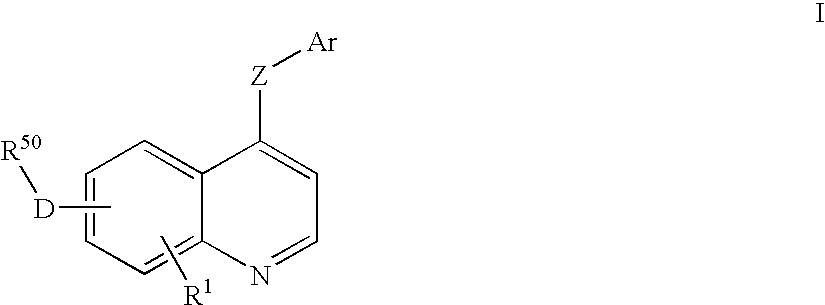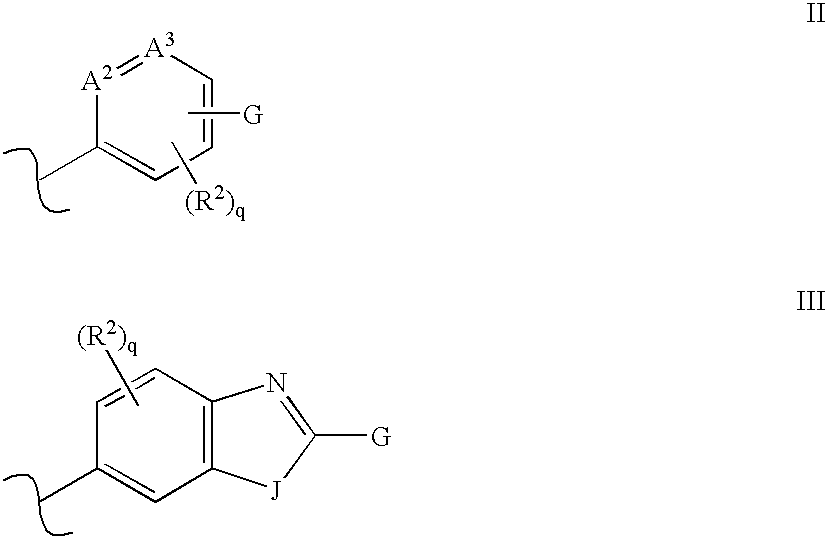C-Met Modulators and Methods of Use
a technology of c-met and modulator, which is applied in the field of compounds for modulating protein kinase enzymatic activity, can solve the problems of ligand-dependent tyrosine kinase activity, uncontrolled cell proliferation, and altered cellular properties
- Summary
- Abstract
- Description
- Claims
- Application Information
AI Technical Summary
Benefits of technology
Problems solved by technology
Method used
Image
Examples
example 1
[0272]
[0273]Synthesis of 1-(4-Benzyloxy-5-methoxy-2-nitro-phenyl)-ethanone. 1-(4-Benzyloxy-3-methoxy-phenyl)-ethanone (200 mmol, 51.3 g) dissolved in DCM (750 ml) and the mixture cooled to 0° C. Nitric acid (90%, 300 mmol, 14 ml) was added dropwise to the cooled solution over 20 minutes. Sulfuric acid (96.2%, 300 mmol, 8.75 ml) was then added dropwise over 40 minutes at 0° C.
[0274]Additional nitric acid (200 mmol, 9.4 ml) was added dropwise over 20 minutes. The reaction mixture was diluted with water (300 ml) and wash with water (3×200 ml), Sat. NaHCO3 (4×200 ml, or until neutral). The organic layer was dried over Na2SO4 and concentrated.
[0275]The crude mixture was recrystallized with DMF to give 22.5 g of the nitro product. The DMF layer was concentrated and recrystallized with ethyl acetate to give additional 8.75 g of the product. The ethyl acetate layer was concentrated and purified on silica column using 20% EtOAc / hexanes to gave another 4.75 g of the product. Total yield is 36...
example 2
[0276]
[0277]Synthesis of 1-(2-Amino-4-benzyloxy-5-methoxy-phenyl)-ethanone. A Mixture of iron powder (477 mmol, 27 g), ammonium acetate (500 mmol, 31.g), 1-(4-Benzyloxy-5-methoxy-2-nitro-phenyl)-ethanone (120 mmol, 36 g), toluene (500 ml) and water (500 ml) was refluxed overnight, or until completion. The mixture was filtered through celite and washed with EtOAc. The organic layer was washed with water and Sat. NaCl, dried over Na2SO4, and concentrated to afford the product, 90%. 1H NMR (CDCl3): 7.408-7.298 (5H, m), 7.130 (1H, s), 6.155 (2H, br), 6.104 (1H, s), 5.134 (2H, s), 3.834 (3H, s), 2.507 (3H, s). LC / MS (M+1=272).
example 3
[0278]
[0279]Synthesis of 7-Benzyloxy-6-methoxy-quinolin-4-ol. To a solution of 1-(2-Amino-4-benzyloxy-5-methoxy-phenyl)-ethanone (108 mmol, 29.3 g) in DME (700 ml) was added sodium methoxide (432 mmol, 23.35 g). The mixture was stirred for 30 minutes. Ethyl formate (540 mmol, 44 ml) was added and the mixture was stirred overnight. (Additional sodium methoxide may be needed if reaction is not complete as monitored by LC / MS.) After the reaction was completion, the mixture was diluted with water (40 ml) and acidified to neutral with 1M HCl. The precipitate was filtered and washed with water, dried in vacuo to afford 22 g (72%) of 7-benzyloxy-6-methoxy-quinolin-4-ol. 1H NMR (CDCl3): 10.7 (1H, br), 7.703 (1H, s), 7.493-7.461 (1H, t), 7.431-7.413 (2H, br d), 7.372-7.333 (2H, t), 7.296-7.283 (1H, d), 6.839 (1H, s), 6.212-6.193 (1H, d), 5.212 (2H, s), 3.965 (3H, s). LC / MS (M+1=282).
PUM
| Property | Measurement | Unit |
|---|---|---|
| body weight | aaaaa | aaaaa |
| molecular weight | aaaaa | aaaaa |
| molecular weight | aaaaa | aaaaa |
Abstract
Description
Claims
Application Information
 Login to View More
Login to View More - R&D
- Intellectual Property
- Life Sciences
- Materials
- Tech Scout
- Unparalleled Data Quality
- Higher Quality Content
- 60% Fewer Hallucinations
Browse by: Latest US Patents, China's latest patents, Technical Efficacy Thesaurus, Application Domain, Technology Topic, Popular Technical Reports.
© 2025 PatSnap. All rights reserved.Legal|Privacy policy|Modern Slavery Act Transparency Statement|Sitemap|About US| Contact US: help@patsnap.com



